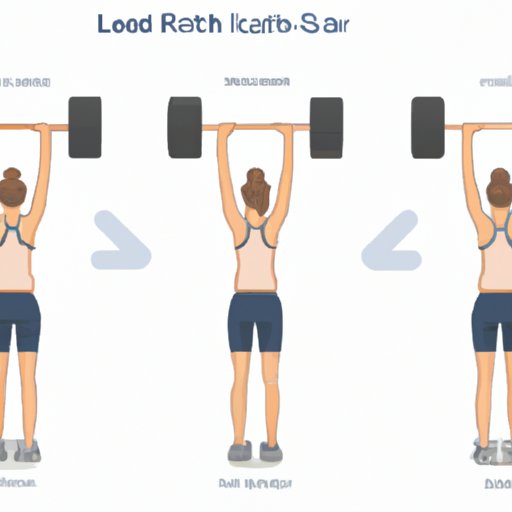
I. Introduction
If you’re looking to strengthen your shoulder muscles and improve upper body posture, the lat raise exercise could be just what you need. Not only is it a great way to target a specific area of the shoulder, but it can also complement other exercises in your fitness routine. In this article, we’ll cover various aspects of the exercise, including proper form, variations, benefits, progression, comparison with other exercises, full-body workout integration, and common mistakes to avoid.
II. 5 Simple Steps to Perfect Your Lat Raise Form
Before we dive into the different variations of the lat raise, it’s important to understand the proper form. Follow these five simple steps:
- Stand with your feet shoulder-width apart, and hold a dumbbell in each hand with palms facing each other.
- Grip the dumbbells tightly and keep your arms straight with elbows slightly bent.
- Slowly raise the dumbbells to shoulder level, making sure to keep your elbows slightly bent and your palms facing the ground.
- Maintain good posture throughout the movement, keeping your shoulders down and back, and your eyes looking forward.
- Breathe in as you raise the dumbbells and exhale as you lower them back down.
Start with lighter weights and gradually increase weight as you become more comfortable with the movement. This will help you avoid injury.
III. 10 Variations of the Lat Raise You Need to Try
Once you’ve mastered the basic lat raise form, it’s time to experiment with different variations. Here are 10 different ways to perform the lat raise that target different parts of the shoulder muscles:
- Dumbbell lat raise
- Cable lat raise
- Front lat raise
- Lateral raise with a twist
- Kettlebell lat raise
- One-arm dumbbell lat raise
- Seated dumbbell lat raise
- Bent-arm lat raise
- Resistance band lat raise
- Barbell lat raise
Each variation has its own unique benefits, so be sure to vary your exercise routine to challenge your shoulder muscles and avoid plateaus.
IV. The Benefits of the Lat Raise and Why You Should Include It in Your Workout
The lat raise exercise offers numerous benefits, including:
- Strengthening the shoulder muscles, including the deltoids and trapezius
- Improving posture by targeting muscles that stabilize the upper body
- Reducing the risk of shoulder injuries by strengthening the rotator cuff muscles
Regardless of your fitness goals, the lat raise should be included in your exercise routine. It can help complement other exercises and contribute to a well-rounded fitness program.
V. How to Progress Your Lat Raise for Maximum Results
If you’re looking to take your lat raise workout to the next level, try these tips:
- Gradually increase weight as you become stronger
- Add more reps or sets to challenge your muscles
- Slow down the movement to increase time under tension
- Incorporate supersetting with other shoulder exercises for a more intense workout
Remember to track your progress and continually challenge yourself to achieve maximum results.
VI. Lat Raises vs. Other Shoulder Exercises: Which is Better?
While the lat raise is an excellent exercise for targeting the shoulder muscles, there are other popular shoulder exercises that offer unique benefits. Here’s a comparison:
- Overhead press: targets not only the shoulder muscles but also the triceps and upper back
- Push-ups: a great bodyweight exercise that targets the chest and triceps as well as the shoulder muscles
- Front raises: targets the front of the shoulder muscles and can help improve posture
Each exercise has its own unique benefits and may be better suited for different fitness goals. Talk to a personal trainer to determine which exercises are best for your individual needs.
VII. How to Incorporate the Lat Raise into a Full-Body Workout
For a well-rounded workout, it’s important to balance different exercises that target different muscle groups. Here’s a sample full-body workout routine that includes the lat raise:
- Lat raise (3 sets of 12 reps)
- Bench press (3 sets of 10 reps)
- Squats (3 sets of 12 reps)
- Deadlifts (3 sets of 8 reps)
- Bicep curls (3 sets of 10 reps)
- Planks (3 sets of 30 seconds)
Remember to customize your workout routine based on your individual goals and fitness level, and always warm up properly before exercising.
VIII. Common Mistakes to Avoid When Doing a Lat Raise
Even with proper form, it’s easy to make mistakes when doing the lat raise exercise. Here are some common mistakes to avoid:
- Using momentum to lift the weights
- Swinging the weights up instead of raising them in a controlled manner
- Using weights that are too heavy
Avoiding these mistakes is important to reduce the risk of injury and ensure maximum results.
IX. Conclusion
The lat raise exercise is a great way to strengthen your shoulder muscles, improve posture, and reduce the risk of injury. By perfecting your form, experimenting with different variations, and incorporating it into a well-rounded workout routine, you can achieve maximum results. Remember to track your progress and avoid common mistakes to ensure proper technique and avoid injury.




